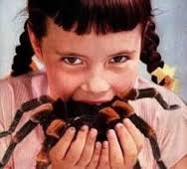I don’t eat bugs. Not in a significant self-aware way, at least. But there are many good reasons to. I want to list the reasons I find most compelling—mainly as an exercise of pre-emptive self-persuasion. So that when I am confronted with a bowl of crickets, I can use these reasons to help me to overcome my culturally-constructed food avoidance.
In other words, I will use reason to get over the gross-out.
By the way, there’s a word for bug-eating. It’s “entomophagy…” an ugly stuffy-sciency word that’s another barrier to overcome.
One big reason eat bugs involve feed conversion rates. It’s well known how unsustainable current animal protein production is. However, compare this to insect protein production.
For example, if you take 10lbs of feed, it gets you the following conventional animal protein:
5lbs of chicken
3lbs of pork
1lb of meat
However, if you take the same amount of feed—10lbs—and give it to crickets, you get…
That’s so much protein!
Since bugs are cold- blooded, they are much more efficient at converting feed to meat than their warm-blooded counterparts…which have to waste energy keeping themselves warm. They also don’t have to grow things that aren’t edible, like bones and fur and beaks. You pretty much eat all of the the cricket.
From sustainability point-of-view, the advantages are clear. You get almost twice as much insect protein from the same amount of feed than you would from chicken. You get 9 times as much as you would from a cow.
With increasing population rates, this type of food source could be a reliable and efficient protein source. It’s already happening in Thailand.
However, is this enough for entomophagy (or better… maybe call it “land-crabbing”?) to take off in the US? Although it’s a lot of crickets, they are still crickets.
Although, I haven’t (knowingly) eaten crickets yet (can’t wait!), the efficiency of their production is a good reason.
Sources:
- GRUB: Eating bugs to save the planet. By Dana Goodyear. New Yorker, August 15, 2011
- TedTalk: Marcel Dicke: Why not eat insects? July 2010
Tags: entomophagy, why eat bugs





July 6, 2014 at 8:35 pm |
An interesting addendum…At Cornell, it was estimated in 1997 that we could feed 800 million people with the grains that are being fed to cows, or $80B in GDP if the grain was sold for export… http://www.news.cornell.edu/stories/1997/08/us-could-feed-800-million-people-grain-livestock-eat
July 8, 2014 at 4:28 pm |
[…] after her incarceration, and not the many racist bus incidents that preceded it. (So if this bug-eating movement is to take off, I need more shallow […]
July 14, 2014 at 5:34 pm |
[…] appeal of the bizarre. There are a lot of good reasons for eating bugs (and have already considered feed-conversion rates and entomophagy’s carbon footprint). The humaneness of its production may also amplify the […]
July 21, 2014 at 7:34 pm |
[…] Like with bugs! […]
August 7, 2014 at 4:41 pm |
[…] 80% of water goes to agriculture for plants and livestock, and half of that goes to feed for livestock–because the animals we eat eat a lot of feed. […]
August 18, 2014 at 3:34 pm |
[…] and any bacteria. I freeze them for 3 days just to be sure. Plus, I’m not eager to do this. Despite all the reasons I’ve accumulated as a pre-emptive self-persuasion to eat bugs, I’m still beholden to my culturally-constructed food avoidance. Plus, it seems a little […]
October 22, 2014 at 5:44 pm |
[…] turned out pretty well. I had a lot to cram in there, and there was way more left out than put in. I’ve been writing a lot about entomophagy recently. (My first draft was an hour […]